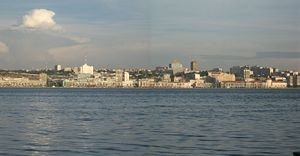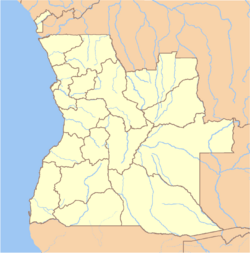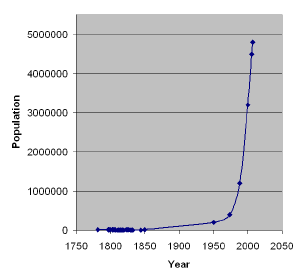Difference between revisions of "Luanda" - New World Encyclopedia
Mike Butler (talk | contribs) |
Mike Butler (talk | contribs) |
||
| Line 163: | Line 163: | ||
== Economy == | == Economy == | ||
{{Main|Economy of Angola}} | {{Main|Economy of Angola}} | ||
| + | Angola has a high growth rate, averaging more than 15 percent each year from 2004 to 2007, driven by its oil sector, which contributes about 85 percent of GDP. A postwar reconstruction boom and resettlement of displaced persons has led to high rates of growth in construction and agriculture as well. | ||
| + | |||
| + | Subsistence agriculture provides the main livelihood for most of the people, but half of the country's food must still be imported. | ||
| + | |||
| + | Angola's per capita GDP was estimated at $9100 in 2008.) | ||
| + | |||
Manufacturing includes processed foods, beverages, textiles, cement and other building materials, plastic products, metalware, cigarettes, and shoes. Petroleum (found in nearby off-shore deposits) is refined in the city, although this facility was repeatedly damaged during the [[Angolan Civil War]] (1975–2002). Luanda has an excellent natural harbour; the chief exports are [[coffee]], [[cotton]], [[sugar]], [[diamond]]s, [[iron]], and [[salt]]. The city also has a thriving building industry, an effect of the nationwide economic boom experienced since 2002, when political stability returned with the end of the civil war. Economic growth is largely supported by [[oil extraction]] activities, although massive [[diversification]] is taking place, so in turn, future generations will be dependent off oil exports. Large [[investment]] (Domestic and International), along with strong economic growth, has dramatically increased construction of all economic sectors in the city of Luanda.<ref name="economist.com">http://www.economist.com/displaystory.cfm?story_id=10316212</ref> | Manufacturing includes processed foods, beverages, textiles, cement and other building materials, plastic products, metalware, cigarettes, and shoes. Petroleum (found in nearby off-shore deposits) is refined in the city, although this facility was repeatedly damaged during the [[Angolan Civil War]] (1975–2002). Luanda has an excellent natural harbour; the chief exports are [[coffee]], [[cotton]], [[sugar]], [[diamond]]s, [[iron]], and [[salt]]. The city also has a thriving building industry, an effect of the nationwide economic boom experienced since 2002, when political stability returned with the end of the civil war. Economic growth is largely supported by [[oil extraction]] activities, although massive [[diversification]] is taking place, so in turn, future generations will be dependent off oil exports. Large [[investment]] (Domestic and International), along with strong economic growth, has dramatically increased construction of all economic sectors in the city of Luanda.<ref name="economist.com">http://www.economist.com/displaystory.cfm?story_id=10316212</ref> | ||
| Line 223: | Line 229: | ||
== External links == | == External links == | ||
{{commonscat}} | {{commonscat}} | ||
| + | * World Fact Book 2009 [https://www.cia.gov/library/publications/the-world-factbook/geos/ao.html Angola] Retrieved February 20, 2009. | ||
* [http://www.luandamap.com www.luandamap.com - Street map of Luanda and other maps of Angola] | * [http://www.luandamap.com www.luandamap.com - Street map of Luanda and other maps of Angola] | ||
* [http://www.angolinks.com www.angolinks.com - Overview of angolan Internet pages] | * [http://www.angolinks.com www.angolinks.com - Overview of angolan Internet pages] | ||
Revision as of 01:51, 20 February 2009
| Luanda formerly spelled Loanda |
|
| Luanda's waterfront | |
| Location of Luanda in Angola | |
| Coordinates: {{#invoke:Coordinates|coord}}{{#coordinates:8|50|18|S|13|14|4|E|type:city | |
|---|---|
| name= }} | |
| Country | Angola |
| Province | Luanda Province |
| Founded | 1575 |
| Population (2007) | |
| - Total | 4,799,432 |
Luanda (formerly spelled Loanda) is the capital and largest city of Angola. Located on Angola's coast with the Atlantic Ocean, Luanda is both Angola's chief seaport and administrative center and has a population of approximately 4.8 million (2007)[1]. It is also the capital city of Luanda Province. As Angola rebuilds after the end of a 27-year civil war in 2002, Luanda was, in 2009, undergoing an extensive reconstruction, that will alter the cityscape significantly.
Geography
Etymology of name – if available. Topography: Physical qualities of a particular place. Example: Mexico City a. Mountain flanked basin b. on dry lake bed c. vulnerability to earthquakes d. trapped air pollution (also true in L.A. and Athens) Elevation Climate (not required unless it makes the city a resort) The city (Johannesburg) enjoys a dry, sunny climate, with the exception of occasional late afternoon downpours in the summer months of October to April. Temperatures are usually fairly mild due to the city's high altitude, with the average maximum daytime temperature in January of 79°F (26°C), dropping to an average maximum of around 61°F (16°C) in June. Winter is the sunniest time of the year, with cool days and cold nights. The temperature occasionally drops to below freezing at night, causing frost. Snow is rare. Mean annual precipitation is 28 inches (716mm). Rivers and canals Size – land area, size comparison Environmental issues Districts
| Climate chart for Luanda | |||||||||||
|---|---|---|---|---|---|---|---|---|---|---|---|
| J | F | M | A | M | J | J | A | S | O | N | D |
25
29
24
|
36
30
25
|
76
31
25
|
117
30
24
|
13
28
23
|
0
25
20
|
0
24
19
|
0
24
19
|
3
25
20
|
5
27
22
|
28
28
23
|
20
29
23
|
| temperatures in °C precipitation totals in mm | |||||||||||
|
Imperial conversion
| |||||||||||
Luanda is divided into two parts, the Baixa de Luanda (lower Luanda, the old city) and the Cidade Alta (upper city or the new part). The Baixa de Luanda is situated next to the port, and has narrow streets and old colonial buildings.
Luanda is the seat of a Roman Catholic archbishop. It is also the location of most of Angola's educational institutions, including the private Catholic University of Angola and the public University of Agostinho Neto. It is also the home of the colonial Governor's Palace and the Estádio da Cidadela (the "Citadel Stadium"), Angola's main stadium, with a total seating capacity of 60,000.
The climate is hot and humid but surprisingly dry, owing to the cool Benguela Current, which prevents moisture from easily condensing into rain. Frequent fog prevents temperatures from falling at night even during the completely dry months from June to October. Luanda has an annual rainfall of 323 millimeters (12.7 in), but the variability is among the highest in the world, with a co-efficient of variation above 40 percent[2]. The short rainy season in March and April depends on a northerly counter current bringing moisture to the city: it has been shown clearly that weakness in the Benguela current can increase rainfall about sixfold compared with years when that current is strong.
History
Portuguese rule
Portuguese explorer Paulo Dias de Novais founded Luanda in 1575 as "São Paulo de Loanda", with a hundred families of settlers and four hundred soldiers. In 1618 the Portuguese built the fortress called Fortaleza São Pedro da Barra, and in 1634 they built another fortress: Fortaleza de São Miguel. Luanda was Portuguese Angola's administrative centre from 1627, with one exception: the Dutch ruled Luanda from 1640 to 1648 as Fort Aardenburgh. The city served as the centre of a large slave trade to Brazil from c.1550 to 1836. The slave trade was conducted mostly with the Portuguese colony of Brazil; Brazilian ships were the most numerous in the ports of Luanda and Benguela. By this time, Angola, a Portuguese colony, was in fact like a colony of Brazil, paradoxically another Portuguese colony. A strong degree of Brazilian influence was noted in Luanda until the Independence of Brazil in 1822. In the 19th century, still under Portuguese rule, Luanda experienced a major economic revolution. The slave trade was abolished in 1836, and in 1844 Angola's ports were opened to foreign shipping. By 1850, Luanda was one of the greatest and most developed Portuguese cities in the vast Portuguese Empire outside Mainland Portugal, full of trading companies, exporting (together with Benguela) palm and peanut oil, wax, copal, timber, ivory, cotton, coffee, and cocoa, among many other products. Maize, tobacco, dried meat and cassava flour also began to be produced locally. The Angolan bourgeoisie was born by this time. In 1889 Governor Brito Capelo opened the gates of an aqueduct which supplied the city with water, a formerly scarce resource, laying the foundation for major growth. Like most of Portuguese Angola, the cosmopolitan[3] city of Luanda was not affected by the Portuguese Colonial War (1961-1974); economic growth and development in the entire region reached record highs during this period. In 1972 a report called Luanda the "Paris of Africa".
Independence from Portugal
By the time of Angolan independence in 1975, Luanda was a modern city and the majority of the city's population was of Portuguese origin. After the Carnation Revolution in April 1974, with the advent of independence and the start of the Angolan Civil War (1975-2002), most of the Portuguese left as refugees, principally for Portugal, with many travelling overland to South Africa. There was an immediate crisis, because the local African population lacked the skills and knowledge needed to run the city and maintain its infrastructure. The large numbers of skilled technicians among the force of Cuban soldiers sent in to support the MPLA government in the Angolan Civil War were able to make a valuable contribution to restoring and maintaining basic services in the city. However, slums called musseques stretched for miles beyond Luanda's former city limits, as a result of the decades-long civil war, and because of the rise of deep social inequalities due to large-scale migration of civil war refugees from other Angolan regions. For decades, Luanda's facilities were not adequately expanded to handle this massive increase in the city's population. After 2002, with the end of the civil war and high economic growth rates fuelled by the wealth provided by the increasing oil and diamond production, major reconstruction started.
Government
Angola has a multiparty presidential republic in which the president, who is both chief of state and head of government, is elected by universal ballot for a five-year term and is eligible for a second consecutive or discontinuous term. The unicameral National Assembly, or Assembleia Nacional, comprises 220 members elected by proportional vote to serve four-year terms.
Economy
Angola has a high growth rate, averaging more than 15 percent each year from 2004 to 2007, driven by its oil sector, which contributes about 85 percent of GDP. A postwar reconstruction boom and resettlement of displaced persons has led to high rates of growth in construction and agriculture as well.
Subsistence agriculture provides the main livelihood for most of the people, but half of the country's food must still be imported.
Angola's per capita GDP was estimated at $9100 in 2008.)
Manufacturing includes processed foods, beverages, textiles, cement and other building materials, plastic products, metalware, cigarettes, and shoes. Petroleum (found in nearby off-shore deposits) is refined in the city, although this facility was repeatedly damaged during the Angolan Civil War (1975–2002). Luanda has an excellent natural harbour; the chief exports are coffee, cotton, sugar, diamonds, iron, and salt. The city also has a thriving building industry, an effect of the nationwide economic boom experienced since 2002, when political stability returned with the end of the civil war. Economic growth is largely supported by oil extraction activities, although massive diversification is taking place, so in turn, future generations will be dependent off oil exports. Large investment (Domestic and International), along with strong economic growth, has dramatically increased construction of all economic sectors in the city of Luanda.[4]
Transportation
Luanda is the starting point of the Luanda railway that goes due east to Malanje, but does not reach Congo-Kinshasa. The civil war left the railway non-functional, but a Chinese firm has taken up a contract to rebuild many Angolan railways, including the Luanda Railway which has already been completed.[5]
The main airport of Luanda is Quatro de Fevereiro Airport, which acts as the largest in the country. Currently, Luanda has a major International Airport under construction is the southern part of the city, which is expected to be opened in 2011. [6]
The port of Luanda is currently serves as the largest port of Angola, and connects Angola to the rest of the world. Major expansion of this port is also taking place, with the completion of a new complex just last year, the port is expanding rapidly. [7]
Luanda's roads are currently in a poor state of repair, but are currently undergoing a massive reconstruction process by the government in order to relieve traffic congestion in the city. Major road repairs can be found taking place in nearly every neighborhood, including a major 6-lane highway connected Luanda to Viana, which is nearing partial completion in October.[8] Many of the citizens of Luanda rely on privately owned combi taxis for transport, although recently the city has invested more into a public bus system.
Major Reconstruction
Angola, which is forecast to be one the world's fastest growing economies [4], has been undergoing a massive national reconstruction. The central government allocates funds to all regions of the country, but the capital region receives the bulk of these funds. Since the end of the Angolan Civil War (1975-2002), stability has been widespread in the country, and major reconstruction has been ongoing since 2002.
Major reconstruction in Luanda has been in nearly all aspects of society. Major road rehabilitation, including road widening, application of asphalt, and re-routing efforts are all currently being done throughout Luanda. The Brazilian construction firm Odebrechet, are currently constructing two six-lane highways. One highway that will provide speedy access to Cacuaco, Viana, Samba, and the Kilamba Kiaxi district of Luanda to the new airport of Luanda.[9] The other highway will connect the city center of Luanda to Viana, and is expected to be completed by the end of 2008. [9]
Major social housing is also being constructed, to house those who currently reside in slums, which dominate the landscape of Luanda. A large Chinese firm has been given a contract to construct the majority of replacement housing in Luanda. [10] The Angolan minister of health recently stated poverty in Angola will be overcome by an increase in jobs, and the housing of every citizen. [11]
Demographics
The inhabitants of Luanda are primarily members of African ethnic groups, including the Ovimbundu, Kimbundu and Bakongo tribes. The official and the most widely used language is Portuguese, although many Bantu-related indigenous languages are also used. There is a small population of European origin.
The population of Luanda has exploded in recent years, due in large part to war-time migration to the city, which is safe compared to the rest of the country.[12] However, Luanda has recently seen an increase in violent crime, particularly in the shanty towns that surround the colonial urban core.[13]
Culture
Notable Residents
- Hugo Ferreira, lead singer of the band Tantric, was born and lived very briefly in Luanda.
Looking to the future
The main thing with NWE is the mission to somehow integrate purpose and values. Wikipedia typically ends articles haphazardly.
Does the city face no challenges or offer up anything else as a legacy?"
Does the city need reconstruction?
Is it a model city?
Will it run out of water?
Does it have a crucial role to play in the nation?
Gallery
ReferencesISBN links support NWE through referral fees
- ↑ http://www.who.int/cholera/countries/Angola%20country%20profile%202007.pdf
- ↑ Dewar, Robert E. and Wallis, James R; "Geographical patterning in interannual rainfall variability in the tropics and near tropics: An L-moments approach"; in Journal of Climate, 12; pp. 3457-3466
- ↑ Mayor's International Council Sister Cities Program. Belo Horizonte, Minas Gerais. Retrieved 2008-08-18.
- ↑ 4.0 4.1 http://www.economist.com/displaystory.cfm?story_id=10316212
- ↑ http://www.chinainternationalfund.com/projects1.asp?Id=284
- ↑ http://www.chinainternationalfund.com/projects1.asp?Id=283
- ↑ http://www.scottwilson.com/projects/transportation/maritime/luanda_oil_service_centre.aspx
- ↑ http://allafrica.com/stories/200808180008.html
- ↑ 9.0 9.1 http://www.otal.com/angola/
- ↑ http://www.chinainternationalfund.com/projects1.asp?Id=287
- ↑ http://www.portalangop.co.ao/motix/pt_pt/noticias/economia/Pobreza-sera-combatida-com-emprego-habitacoes-sociais-diz-ministro-adjunto,d4542ae2-820b-4c6b-bdee-85dc280983b5.html
- ↑ International Spotlight: Angola
- ↑ ANGOLA: Easy access to guns concern as election nears
External links
- World Fact Book 2009 Angola Retrieved February 20, 2009.
- www.luandamap.com - Street map of Luanda and other maps of Angola
- www.angolinks.com - Overview of angolan Internet pages
- www.cidadeluanda.com - Luanda, city map, History, Photos
Credits
New World Encyclopedia writers and editors rewrote and completed the Wikipedia article in accordance with New World Encyclopedia standards. This article abides by terms of the Creative Commons CC-by-sa 3.0 License (CC-by-sa), which may be used and disseminated with proper attribution. Credit is due under the terms of this license that can reference both the New World Encyclopedia contributors and the selfless volunteer contributors of the Wikimedia Foundation. To cite this article click here for a list of acceptable citing formats.The history of earlier contributions by wikipedians is accessible to researchers here:
The history of this article since it was imported to New World Encyclopedia:
Note: Some restrictions may apply to use of individual images which are separately licensed.






